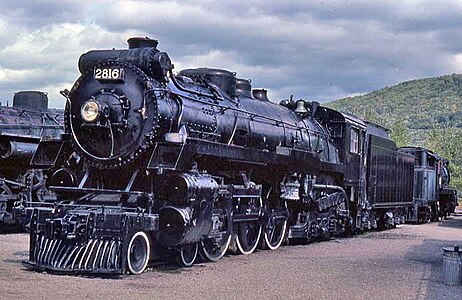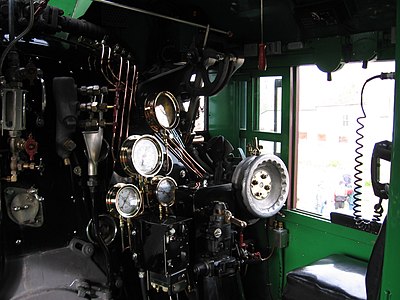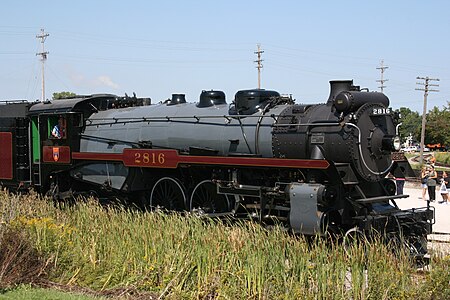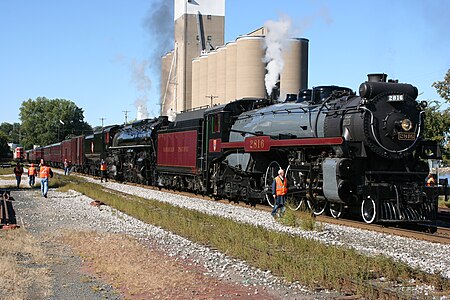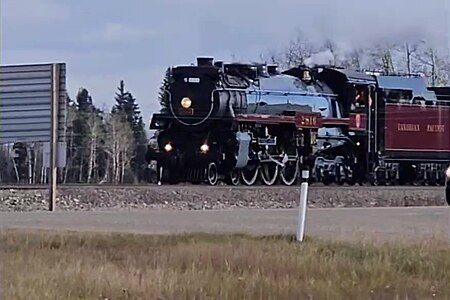Canadian Pacific 2816: Difference between revisions
No edit summary |
No edit summary |
||
| Line 59: | Line 59: | ||
==History== |
==History== |
||
===Revenue service=== |
===Revenue service=== |
||
No. 2816 was one of ten H-1b-class (the "H" meant the 4-6-4 wheel configuration, the "1" was the design number and the "b" meant it was the second production run) 4-6-4 Hudson-type built by the Montreal Locomotive Works in December 1930.<ref name="Steamtown">{{Cite web|title=Canadian Pacific Railway No. 2816|url=https://www.nps.gov/parkhistory/online_books/steamtown/shs3g.htm|publisher=[[National Park Service]]|accessdate=March 2, 2019|archive-url=https://web.archive.org/web/20190302023943/https://www.nps.gov/parkhistory/online_books/steamtown/shs3g.htm|archive-date=March 2, 2019}}</ref> It was first assigned to the line between [[Winnipeg]] and [[Fort William, Ontario]].<ref name="Steamtown"/> |
No. 2816 was one of ten H-1b-class (the "H" meant the 4-6-4 wheel configuration, the "1" was the design number and the "b" meant it was the second production run) 4-6-4 Hudson-type built by the Montreal Locomotive Works in December 1930.<ref name="Steamtown">{{Cite web|title=Canadian Pacific Railway No. 2816|url=https://www.nps.gov/parkhistory/online_books/steamtown/shs3g.htm|publisher=[[National Park Service]]|accessdate=March 2, 2019|archive-url=https://web.archive.org/web/20190302023943/https://www.nps.gov/parkhistory/online_books/steamtown/shs3g.htm|archive-date=March 2, 2019}}</ref> It was first assigned to the line between [[Winnipeg]] and [[Fort William, Ontario]].<ref name="Steamtown"/> With the introduction of semi-streamlined Royal Hudson locomotives in 1937, No. 2816 was reassigned to service between [[Windsor, Ontario]], and [[Quebec City]], and later, it ran a [[Commuter rail|commuter train]] between [[Montreal]] and [[Rigaud, Quebec]].<ref name="Steamtown"/><ref name=":1">{{Cite magazine |last=Stephens |first=Bill |date=July 2000 |title=Railroad News - CP 4-6-4 2816 to head program |url=https://www.trains.com/trn/magazine/archive-access/trains-july-2000/ |url-access=limited |access-date=May 6, 2024 |magazine=Trains |publisher=Kalmbach Publishing |page=20 |volume=60 |issue=7}}</ref> No. 2816 received its last major overhaul in revenue service in 1957, with its tender being replaced with one from Royal Hudson No. 2822.<ref name=":1" /><ref name=":2">{{Cite magazine |last=Stephens |first=Bill |date=November 2000 |title=Railroad News - CP 2816 overhaul to go into 2001 |url=https://www.trains.com/trn/magazine/archive-access/trains-november-2000/ |url-access=limited |access-date=May 6, 2024 |magazine=Trains |publisher=Kalmbach Publishing |pages=26-28 |volume=60 |issue=11}}</ref> The locomotive was retired from revenue service on May 26, 1960, after accumulating {{convert|2,046,000|mi|km|order=out|abbr=off}}.<ref name=Trains-July2000-Stephens>{{cite journal|last=Stephens|first=Bill|date=July 2000|title=CP 4-6-4 2816 to head program|journal=Trains|publisher=Kalmbach Publishing|location=Waukesha, WI|volume=60|issue=7|page=20|issn=0041-0934}}</ref><ref>{{Cite web|url=https://railfan.com/canadian-pacific-fires-up-2816-for-first-time-in-eight-years/|title=CP Fires up Steam Locomotive for First Time in Eight Years|date=14 November 2020}}</ref><ref name="CanadianRailJanuary-February2002"/><ref name="CP2816"/> |
||
===Steamtown ownership=== |
===Steamtown ownership=== |
||
In the early 1960s, [[F. Nelson Blount]] wanted to expand his [[Steamtown, U.S.A.]] collection, and one of the locomotives he initially wanted to preserve was a [[New York Central Hudson|4-6-4 from the New York Central Railroad]] (NYC). Since all NYC 4-6-4s were scrapped by that time, Blount improvised by purchasing No. 2816 from the CPR in January 1964, and it became the only 4-6-4 in the collection. The locomotive was put on static display at Steamtown in [[Bellows Falls, Vermont]] for several years |
In the early 1960s, [[F. Nelson Blount]] wanted to expand his [[Steamtown, U.S.A.]] collection, and one of the locomotives he initially wanted to preserve was a [[New York Central Hudson|4-6-4 from the New York Central Railroad]] (NYC). Since all NYC 4-6-4s were scrapped by that time, Blount improvised by purchasing No. 2816 from the CPR in January 1964, and it became the only 4-6-4 in the collection. The locomotive was put on static display at Steamtown in [[Bellows Falls, Vermont]] for several years, and then in the winter of 1983-1984, it was moved along with the rest of the collection to [[Scranton, Pennsylvania]], where the name was later changed to [[Steamtown National Historic Site]] under the ownership of the [[National Park Service]].<ref name="Steamtown"/> During No. 2816’s time on static display, the locomotive began to deteriorate from the outdoor elements, and it remained in that condition for thirty-five years in New England and Pennsylvania.<ref>{{Cite web |date=2022-02-08 |title=Canadian Pacific 2816 The Empress steam locomotive profile |url=https://www.trains.com/trn/railroads/locomotives/canadian-pacific-2816-the-empress-steam-locomotive-profile/ |access-date=2023-07-03 |website=Trains |language=en-US}}</ref> |
||
===Restoration=== |
===Restoration=== |
||
In September 1998, the Canadian Pacific purchased No. 2816 after hearing of its availability from the crews who were running CPR [[Royal Hudson|Royal Hudson No. 2860]].<ref name="BranchlineOctober2001" /><ref name=":0">{{Cite magazine |date=December 1998 |title=CP sponsors unique trek |url=https://www.trains.com/trn/magazine/archive-access/trains-december-1998/ |url-access=limited |access-date=May 6, 2024 |magazine=Trains |publisher=Kalmbach Publishing |page=21 |volume=58 |issue=12}}</ref> The No. 2860 crews had been looking for replacement parts for the Royal Hudson and were offered to buy the entire locomotive.<ref name="BranchlineOctober2001">{{Cite magazine|last=Smith|first=Ian|date=October 2001|title=CPR 2816 Reborn for 21st-Century Service|url=https://www.bytownrailwaysociety.ca/phocadownload/branchline/2001/2001-10.pdf|magazine=Branchline|publisher=Bytown Railway Society|pages=8–9|accessdate=March 4, 2019|archive-url=https://web.archive.org/web/20190304172248/https://www.bytownrailwaysociety.ca/phocadownload/branchline/2001/2001-10.pdf|archive-date=March 4, 2019}}</ref> That same month, No. 2816 was towed from Scranton to Montreal via Binghamton and Albany, New York, and then it was ferried cross country to the [[BC Rail]] workshop in [[Vancouver]], [[British Columbia]].<ref name="BranchlineOctober2001" /><ref name=":0" /> |
In September 1998, the Canadian Pacific purchased No. 2816 after hearing of its availability from the crews who were running CPR [[Royal Hudson|Royal Hudson No. 2860]].<ref name="BranchlineOctober2001" /><ref name=":0">{{Cite magazine |date=December 1998 |title=CP sponsors unique trek |url=https://www.trains.com/trn/magazine/archive-access/trains-december-1998/ |url-access=limited |access-date=May 6, 2024 |magazine=Trains |publisher=Kalmbach Publishing |page=21 |volume=58 |issue=12}}</ref> The No. 2860 crews had been looking for replacement parts for the Royal Hudson and were offered to buy the entire locomotive.<ref name="BranchlineOctober2001">{{Cite magazine|last=Smith|first=Ian|date=October 2001|title=CPR 2816 Reborn for 21st-Century Service|url=https://www.bytownrailwaysociety.ca/phocadownload/branchline/2001/2001-10.pdf|magazine=Branchline|publisher=Bytown Railway Society|pages=8–9|accessdate=March 4, 2019|archive-url=https://web.archive.org/web/20190304172248/https://www.bytownrailwaysociety.ca/phocadownload/branchline/2001/2001-10.pdf|archive-date=March 4, 2019}}</ref> That same month, No. 2816 was towed from Scranton to Montreal via Binghamton and Albany, New York, and then it was ferried cross country to the [[BC Rail]] workshop in [[Vancouver]], [[British Columbia]].<ref name="BranchlineOctober2001" /><ref name=":0" /> |
||
Upon arrival at the shop, No. 2816 was completely disassembled |
Upon arrival at the shop, No. 2816 was completely disassembled.<ref name=rebirth>{{cite journal| title=Rebirth of a mechanical Wonder| journal=CPR News| issue=2| year=2001| url=http://members.shaw.ca/cprsteam/cp2816.htm}}</ref> The restoration team was able to obtain over 800 technical drawings of CPR H1b class locomotives from the [[Canada Science and Technology Museum]], and they used them as references to thoroughly restore No. 2816 to its original specifications.<ref name=rebirth /> During the process, contractors were hired to repair certain parts of No. 2816, including the driving wheels, which were contracted to the [[Tennessee Valley Railroad Museum]] (TVRM) in [[Chattanooga, Tennessee]], and the boiler, which was contracted to Doyle McCormack and his crews in [[Portland, Oregon]].<ref name=":2" /><ref name="BranchlineOctober2001" /> The locomotive was also converted from coal to oil firing, CPR had so much faith in the project that on April 19, 2000, the railway announced that No. 2816 would become an ambassador for their new heritage steam program, and the locomotive was scheduled to return to service in September, but the deadline was pushed back, due to challenges encountered in the restoration process.<ref name=":1" /><ref name=":2" /><ref name=Trains-July2000-Stephens /> The project took over two years and cost over $2,000,000 to complete, making it one of the most expensive steam locomotive restoration projects in Canada. |
||
===First excursion service=== |
===First excursion service=== |
||
Revision as of 16:55, 6 May 2024
| Canadian Pacific 2816 | |||||||||||||||||||||||||||||||||||||||||||||||||||||||||||||||
|---|---|---|---|---|---|---|---|---|---|---|---|---|---|---|---|---|---|---|---|---|---|---|---|---|---|---|---|---|---|---|---|---|---|---|---|---|---|---|---|---|---|---|---|---|---|---|---|---|---|---|---|---|---|---|---|---|---|---|---|---|---|---|---|
CPR No. 2816 Empress leading an excursion on May 10, 2008 | |||||||||||||||||||||||||||||||||||||||||||||||||||||||||||||||
| |||||||||||||||||||||||||||||||||||||||||||||||||||||||||||||||
| |||||||||||||||||||||||||||||||||||||||||||||||||||||||||||||||
| |||||||||||||||||||||||||||||||||||||||||||||||||||||||||||||||
| |||||||||||||||||||||||||||||||||||||||||||||||||||||||||||||||
Canadian Pacific 2816, also known as the "Empress", is a preserved class "H-1b" 4-6-4 Hudson-type steam locomotive built by the Montreal Locomotive Works (MLW) in December 1930 for the Canadian Pacific Railway (CPR). It is the only non-streamlined H1 Hudson to have survived into preservation.
After being used for heavy passenger service, the locomotive was retired in 1960 and donated to Steamtown, U.S.A. at Bellows Falls, Vermont, in 1964. After an extensive restoration, the locomotive returned to service in 2001 and was used by the CPR in occasional excursion service until the discontinuation of the steam program in 2012, after which it remained stored in Calgary, Alberta, Canada. After being teased for a potential return in 2021, No. 2816 returned to service in spring of 2024.
History
Revenue service
No. 2816 was one of ten H-1b-class (the "H" meant the 4-6-4 wheel configuration, the "1" was the design number and the "b" meant it was the second production run) 4-6-4 Hudson-type built by the Montreal Locomotive Works in December 1930.[1] It was first assigned to the line between Winnipeg and Fort William, Ontario.[1] With the introduction of semi-streamlined Royal Hudson locomotives in 1937, No. 2816 was reassigned to service between Windsor, Ontario, and Quebec City, and later, it ran a commuter train between Montreal and Rigaud, Quebec.[1][2] No. 2816 received its last major overhaul in revenue service in 1957, with its tender being replaced with one from Royal Hudson No. 2822.[2][3] The locomotive was retired from revenue service on May 26, 1960, after accumulating 2,046,000 miles (3,293,000 kilometres).[4][5][6][7]
Steamtown ownership
In the early 1960s, F. Nelson Blount wanted to expand his Steamtown, U.S.A. collection, and one of the locomotives he initially wanted to preserve was a 4-6-4 from the New York Central Railroad (NYC). Since all NYC 4-6-4s were scrapped by that time, Blount improvised by purchasing No. 2816 from the CPR in January 1964, and it became the only 4-6-4 in the collection. The locomotive was put on static display at Steamtown in Bellows Falls, Vermont for several years, and then in the winter of 1983-1984, it was moved along with the rest of the collection to Scranton, Pennsylvania, where the name was later changed to Steamtown National Historic Site under the ownership of the National Park Service.[1] During No. 2816’s time on static display, the locomotive began to deteriorate from the outdoor elements, and it remained in that condition for thirty-five years in New England and Pennsylvania.[8]
Restoration
In September 1998, the Canadian Pacific purchased No. 2816 after hearing of its availability from the crews who were running CPR Royal Hudson No. 2860.[9][10] The No. 2860 crews had been looking for replacement parts for the Royal Hudson and were offered to buy the entire locomotive.[9] That same month, No. 2816 was towed from Scranton to Montreal via Binghamton and Albany, New York, and then it was ferried cross country to the BC Rail workshop in Vancouver, British Columbia.[9][10]
Upon arrival at the shop, No. 2816 was completely disassembled.[11] The restoration team was able to obtain over 800 technical drawings of CPR H1b class locomotives from the Canada Science and Technology Museum, and they used them as references to thoroughly restore No. 2816 to its original specifications.[11] During the process, contractors were hired to repair certain parts of No. 2816, including the driving wheels, which were contracted to the Tennessee Valley Railroad Museum (TVRM) in Chattanooga, Tennessee, and the boiler, which was contracted to Doyle McCormack and his crews in Portland, Oregon.[3][9] The locomotive was also converted from coal to oil firing, CPR had so much faith in the project that on April 19, 2000, the railway announced that No. 2816 would become an ambassador for their new heritage steam program, and the locomotive was scheduled to return to service in September, but the deadline was pushed back, due to challenges encountered in the restoration process.[2][3][4] The project took over two years and cost over $2,000,000 to complete, making it one of the most expensive steam locomotive restoration projects in Canada.
First excursion service
On August 16, 2001, restoration work was completed and the engine moved again under its own power for the first time in forty one years in a test run.[6][7] In September 2001, the locomotive made its first trial run from the BC Rail steam shops to its new home of Calgary.[6] It then rejoined the Canadian Pacific fleet as a special excursion locomotive and for public relations. Among other uses, No. 2816 is used to raise money for school lunch programs and the Children's Wish Foundation.[12]
Between 2001 and 2011, No. 2816 travelled across Canada and the United States. On May 16, 2002, the locomotive pulled two excursion trains for the West Coast Express. On September 27, 2003, No. 2816 participated in a doubleheader excursion with Canadian National 2-8-0 No. 2141.
At the end of the 2008 season, Canadian Pacific put the steam program on hold (with exception of previously promised engagements) due to financial issues caused by the poor economy. No. 2816 did not operate at all in 2009, although the steam program was able to take advantage of this down time to do some extensive maintenance work on No. 2816 and its passenger car fleet. No. 2816 returned to operation on June 6, 2010. It was used in Rocky Mountain Express, a 2011 IMAX film which follows the locomotive on a journey from Vancouver to Montreal while telling the CPR's history. In 2011, the No. 2816 had the honour of pulling a special excursion train called the “Royal Canadian Pacific”. The engine made its last run in the summer of 2011 to promote the Children’s Wish Foundation.[13]
Temporary hiatus
In late 2012, Canadian Pacific CEO Fred Green stepped down and E. Hunter Harrison succeeded him.[13] The latter had no interest in steam locomotive operations and discontinued the steam program,[13] forcing No. 2816's excursion operations to be ceased and the locomotive placed in storage in Calgary.[13] Even after Harrison stepped down in early 2017, being succeeded by Keith Creel, the engine remained in storage.[14]
Second excursion service
On November 13, 2020, No. 2816 was fired up for a steam test and moved around the Calgary Yard with a railroad representative saying the test was to assess the engine's mechanical condition with "no plans to operate the engine on the main lines." It was subsequently announced that the locomotive would make a run as part of filming a Holiday Train video.[15][16]
In 2021, Creel said that if the United States Surface Transportation Board approves the CPR's merger with the Kansas City Southern Railway, the railway would celebrate it by bringing No. 2816 back under steam to lead a tour from Calgary to Mexico City, making No. 2816 the first steam locomotive to run through Canada, the United States, and Mexico. However, the locomotive was in need of an overhaul, which was completed in June 2023. Canadian Pacific Kansas City plans to begin No. 2816's tour in spring 2024.[17][18][19] As of June 2023, the locomotive was under testing,[20] and on July 11, the Empress made a run from Calgary to Carseland and back as part of her shakedown runs. Further shakedown runs and tests were performed in August, from Calgary to Coalhurst and back. In October of 2023, two back-to-back test runs from Calgary to Edmonton and back to Calgary then from Calgary to Medicine Hat and back to Calgary concluded testing for 2816 in 2023.[21] On April 24, 2024, No. 2816 began its Final Spike Steam Tour, running from Calgary, Alberta to Mexico City.[22]
Preservation and other remaining H1 Hudsons
Of the five surviving Canadian Pacific Hudsons out of the original 65 built between 1929 and 1940, No. 2816 is the only survivor of the non-streamlined H1a and H1b classes built in 1929 and 1930 numbered 2800–2819.[1] The four other remaining sister engines to 2816 are the semi-streamlined Royal Hudsons numbered 2820–2864. The remaining four Royal Hudsons are Nos. 2839 (H1c), 2850 and 2858 (both H1d) and the 2860 (H1e). As of 2024[update], No. 2816 is the only operating 4-6-4 Hudson in North America; no American 4-6-4 Hudsons are operational.
Gallery
-
CPR No. 2816 on static display at Steamtown, U.S.A. in Bellows Falls, Vermont in 1978
-
The engineer's side of No. 2816's control cab
-
CPR No. 2816 Empress stopped in Sturtevant, Wisconsin on September 1, 2007
-
CPR No. 2816 leading a doubleheader with Milwaukee Road 261 in Red Wing, Minnesota on September 15, 2007
-
CPR No. 2816 passing through Millet, Alberta on October 17, 2023
See also
- Canadian Pacific 1201
- Canadian Pacific 1293
- Canadian Pacific 2317
- Canadian National 6060
- Union Pacific 844
- Southern Pacific 4449
References
- ^ a b c d e "Canadian Pacific Railway No. 2816". National Park Service. Archived from the original on March 2, 2019. Retrieved March 2, 2019.
- ^ a b c Stephens, Bill (July 2000). "Railroad News - CP 4-6-4 2816 to head program". Trains. Vol. 60, no. 7. Kalmbach Publishing. p. 20. Retrieved May 6, 2024.
- ^ a b c Stephens, Bill (November 2000). "Railroad News - CP 2816 overhaul to go into 2001". Trains. Vol. 60, no. 11. Kalmbach Publishing. pp. 26–28. Retrieved May 6, 2024.
- ^ a b Stephens, Bill (July 2000). "CP 4-6-4 2816 to head program". Trains. 60 (7). Waukesha, WI: Kalmbach Publishing: 20. ISSN 0041-0934.
- ^ "CP Fires up Steam Locomotive for First Time in Eight Years". 14 November 2020.
- ^ a b c "CPR 2816 Back in Steam After 40 Years" (PDF). Canadian Rail. Canadian Railroad Historical Association. January–February 2002. p. 3. Archived from the original (PDF) on March 31, 2016. Retrieved February 27, 2019.
- ^ a b "Cordova Bay Station - 2816 on the Internet".
- ^ "Canadian Pacific 2816 The Empress steam locomotive profile". Trains. 2022-02-08. Retrieved 2023-07-03.
- ^ a b c d Smith, Ian (October 2001). "CPR 2816 Reborn for 21st-Century Service" (PDF). Branchline. Bytown Railway Society. pp. 8–9. Archived from the original (PDF) on March 4, 2019. Retrieved March 4, 2019.
- ^ a b "CP sponsors unique trek". Trains. Vol. 58, no. 12. Kalmbach Publishing. December 1998. p. 21. Retrieved May 6, 2024.
- ^ a b "Rebirth of a mechanical Wonder". CPR News (2). 2001.
- ^ "2816 Empress steam train launches tour benefiting the Children's Wish Foundation of Canada". May 24, 2011. Archived from the original on March 14, 2012. Retrieved March 11, 2012.
- ^ a b c d Gunnoe, Chase (November 19, 2015). "CP or NS: which has a soul for preservation?". Trains. Archived from the original on February 25, 2018. Retrieved February 27, 2019.
- ^ "Canadian Pacific Railway says CEO Hunter Harrison stepping down immediately". CBC News. January 18, 2017. Archived from the original on January 18, 2017. Retrieved April 27, 2019.
- ^ Franz, Justin (November 14, 2020). "Update: CP Fires Up Steam Locomotive For First Time in Eight Years". Railfan & Railroad Magazine.
- ^ Glischinski, Steve (November 14, 2020). "Canadian Pacific No. 2816 to steam again for Holiday Train video (corrected)". Trains Magazine. Kalmbach Media. Archived from the original on November 21, 2020. Retrieved November 18, 2020.
- ^ "2022 Railroaders of the Year: Keith Creel and Pat Ottensmeyer, 'Transnational Team'". Railway Age. 2022-01-13. Retrieved 2022-01-23.
- ^ Franz, Justin (2023-06-01). "CPKC Says Steam Locomotive 2816 to Run 'This Summer'". Railfan & Railroad Magazine. Retrieved 2023-06-05.
- ^ "CP 4-6-4 No. 2816 to embark on Canada-U.S.-Mexico tour in 2024". Trains. 2023-07-18. Retrieved 2023-07-18.
- ^ "Canadian Pacific 4-6-4 No. 2816 undergoes stationary steam test". Trains. Retrieved 2023-06-26.
- ^ Franz, Justin (October 23, 2023). "CP 2816 Finishes Season of Testing With Run on Transcontinental Main Line". Railfan & Railroad Magazine. Retrieved January 13, 2024.
- ^ "CP 2816 begins Final Spike tour". Trains. Kalmbach Media. April 26, 2024. Archived from the original on April 27, 2024. Retrieved April 28, 2024.
Further reading
- Boyd, Jim (2011). Steamtown In Color. Scotch Plains, New Jersey: Morning Sun Books, Inc. ISBN 1582483000.
External links
 Media related to Canadian Pacific Railway 2816 at Wikimedia Commons
Media related to Canadian Pacific Railway 2816 at Wikimedia Commons- Rocky Mountain Express
- CP 2816 Empress
